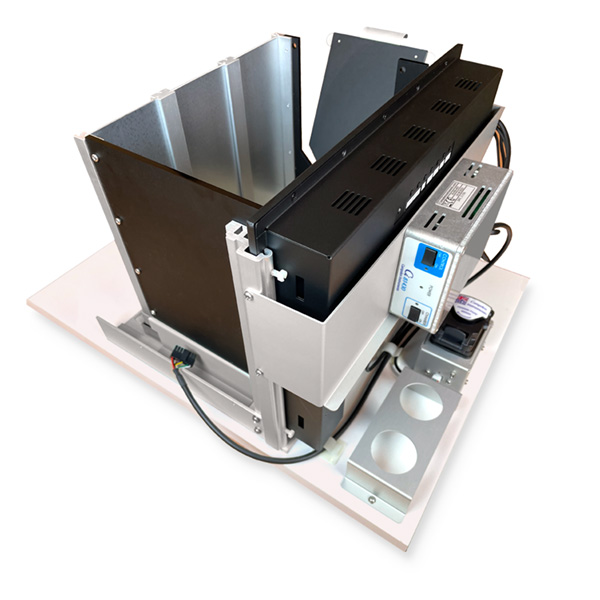
Entry-level modular touch screen chamber incorporates an optimized square wall structure with many add-on options available to tailor your chamber to fit even the most unique requirements.
First developed in 2009 at Cambridge University, the Bussey Saksida Rodent Touch Screen Chamber family is now used by over 300 different Research Groups in at least 26 countries. The original Bussey-Saksida Touch Screen Chamber - now in its second generation is has always featured a unique trapezoidal wall shape in order to focus the animal's attention. Our new system improves the efficient and high-throughput evaluation of rodents.
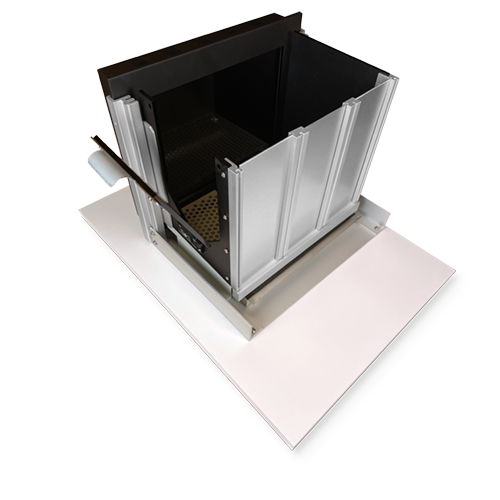
The Second-Generation Bussey-Saksida Rodent Touch Screen Chamber is now available with a square wall structure optimized for use with many modular configurations. Known as the Bussey-Saksida Open Modular Touch Screen Chamber, this new package further simplifies set up for levers, lights, and a range of other operators to accommodate any task with striking similarity to a traditional operant chamber.
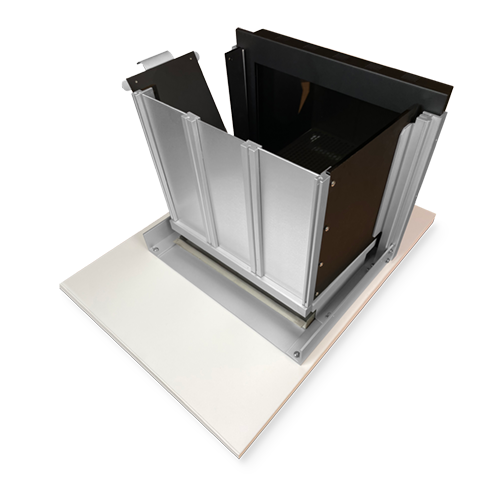
The Second Generation Bussey-Saksida chamber was built with video in mind. New non-reflective walls and floors will aid video tracking, and IR and ambient lighting located under the chamber lid provide even lighting of the chamber and eliminate glare.
Many accommodations for tethers can be made including updated lid and open reward areas to accommodate headstages. A convenient sliding drawer can be added to the environmental cabinet to neatly store and feed the tether.
All electronic components are adjusted to reduce EMC. The environmental cabinet is a Faraday cage to prevent outside noise from the surrounding area from entering the chamber. Even the touch screen itself is shielded to reduce noise emission.
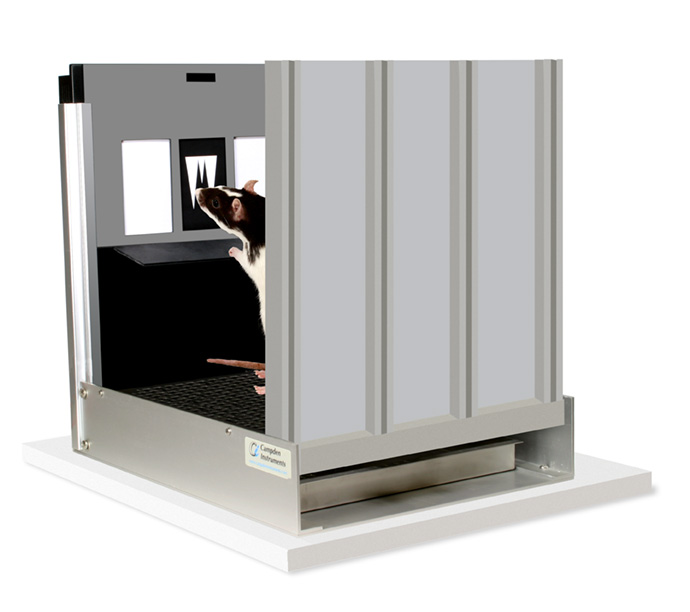
The Bussey-Saksida chamber allows usage of standard, original, and customized paradigms. The rodent tasks range from simple to complex and are Translational to the same Tasks used with NHP and human populations on the Cambridge Neurological Test Automation Battery (CANTAB) system. All paradigms include training routines as well as the main experimental paradigm and the data analysis sets. Certain standard tasks may require the full high cognition touch screen chamber.
| NHP/Human CANTAB Equivalent | Standard Tasks | Typical time to reach baseline | Example neural systems involved | Clinical area showing impairment |
| NHP | Pretraining to touch an image and initiate a trial | 1-2 weeks | Learning | |
| Human/NHP | Pairwise / Visual Discrimination (PD) and Reversal Learning | Pretraining + 5-7 sessions test to reach base line | Prefrontal Cortex, Perirhinal Cortex, Anterior Cingulate, Posterior Cingulate, Medial Frontal Cortex, Striatum, Dopamine system, Cholinergic system, NMDA receptors. Mediodorsal Nucleus of the Thalamus | Huntington's, Schizophrenia, Parkinson's, Learning, Cognitive Flexibility, Executive Function. |
| NHP | Visuomotor Conditional Learning for Rodents (VMCL) | Pretraining + Approximately 20 sessions | Dorsal Striatum, Posterior Cingulate Cortex | Huntington's, Parkinson's |
| NHP | Location Discrimination for Rodents (LD) | Pretraining + 10-20 sessions | Hippocampus, Neurogenesis | Alzheimer's, Schizophrenia |
| NHP | Extinction for Rodents (EXT) | Approximately 4 sessions training + a sessions days extinction | Infralimbic Cortex, Striatum and Amygdala | ADHD, OCD |
| NHP | Progressive Ratio and Effort Related Choice Task for Rodents (PR/ERC) | 16 sessions from first habituation to reach stable PR performance | Dopamine | Motivation, Decision Making |
The Touch Screen has been used to develop a wide range of tasks, probing different areas of cognition, most of which are available ready written with programs and information to train the rodents to the task.
The design of the Touch Screen chamber and the tasks were both found to be crucial to get good and consistent results - comparable results have been achieved by labs all over the world using the Lafayette/Campden Touch Screen and these prewritten tasks. Implementation of the smooth trapeziodal walls and extra sensitive Touch Screens significantly reduced the training times and rodent performance – minimizing distraction and making sure all nosepokes to the screen are detected.
As well as being able to compare results with other rodent Touch Screen work, the chambers also lend themselves to comparing with both NHP and Human Touch Screen Tasks.
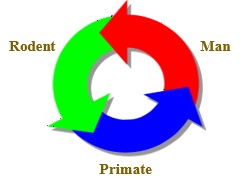
Human CANTAB was developed at Cambridge University, UK, from well-known animal models of behaviour. This has allowed the development of a range of cognitive tests proven to be sensitive to specific regions of the brain. These language free Human CANTAB tests have been further developed to make them suitable for monkey studies - incorporating as few changes as possible.
Monkey CANTAB was developed by a group including Drs T.W. Robbins and A.C. Roberts at the Department of Experimental Psychology, University of Cambridge, England, to improve the comparative assessment from animals to humans. The result is a battery of tests that can be used to study cognition in both experimental primates in the laboratory and humans in the clinic. Link to Monkey CANTAB Page
Professors Tim Bussey and Lisa Saksida at the Cognitive Systems Neuroscience Laboratory, University of Cambridge, England have also developed rodent touchscreen chambers and tasks for rats and mice to again find tasks that are translational to human cognitive tests.
An important consideration in the development translational tasks has been to maximise the likelihood that the same cognitive abilities are used by both animals and humans to perform each test. Consequently, complex tasks are broken down into their constituent elements and each element assessed independently of the next in a step-by-step progression through the test. Guiding a subject through the test in this way restricts the use of alternative strategies and permits an analysis of performance in terms of the cognitive components involved. Functional equivalence is suggested if the pattern of performance of animals and humans, at each stage of the test, is qualitatively similar and if comparable impairments are seen following damage to selective brain structures. A growing bibliography is building evidence that this is the case.
Key Paper - Touchscreen cognitive testing: Cross-species translation and co-clinical trials in neurodegenerative and neuropsychiatric disease, Palmer et al, Neurobiology of Learning and Memory, 2021, 107443.
One case in point concerns the Paired Associate Learning Task (PAL). In human studies early onset Alzheimer’s patients have shown significant deficiencies on this task. Humans with a DLG2 mutation have been found to be impaired on PAL. Likewise DLG2 knock out mice show impairment as shown here. [Nithianantharajah et al, Nature Neuroscience, 2013, 16]
Several strains of rats and mice have been used in the touchscreen chambers, including transgenic and knock out animals.
In a Lab Animal Review article it is also argued that the translational nature the tasks, the lack of aversive stimuli and the wide range of psychological constructs that can be evaluated, means the touchscreen method can yield significant 3Rs (Replacement, Reduction and Refinement) benefits.
Adapted for rats, this reversal learning task requires inhibition of prepotent responses and is known to be dependent on the prefrontal cortex.
Adapted for rats, this is a simple, but powerful, test of behavioral inhibition.
Adapted for rats, this touch screen task has been shown equivalent to those performed with levers or nose-poke holes in measuring motivation and reward-related decision making.
Adapted for rats, this is a habit or stimulus-response task in which the rodent learns a conditional rule.
Adapted for rats, this is a spatial memory task with a reversal learning component. It is sensitive to hippocampal lesions and associated with glutamate receptor regulation and signaling.
The Second Generation Bussey Chambers with Intelli-interface supports up to 20 chambers on one PC. On the strength of 10 years of feedback and development, the system is even more flexible and with more features.
ABET Core Intelli-interface is a smart interface which controls all aspects of your chambers including touchscreen and computer-generated audio.
From writing schedules to analyzing data, ABET Cognition gives you the powerful and flexible tools necessary to control a network of touch screen chamber systems.







